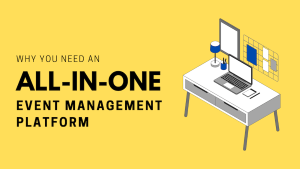
Students juggling classes, part-time jobs, extracurricular activities and social commitments greatly appreciate and benefit from the existence of what we call ‘day notifications’. For the students who’ve missed information about an important seminar simply because an email got buried in their inbox. And for the professors who’ve seen only empty lecture halls despite weeks of meticulous event planning, the answer might be sitting right in everyone’s pocket.
One tiny push notification may seem small, but its larger impact on academic engagement is far from insignificant. It creates and sustains ripples of productivity. The academic event world has changed dramatically over the past few years. Professors are now organizing workshops, guest lectures and symposiums that can potentially lead students to greater opportunities. Yet somehow, these two groups keep missing each other.
The traditional email blast sits unread and the good old poster on the notice board goes unnoticed, camouflaging itself within a bustling college corridor. An announcement that may be made in class reaches only those who attended that particular day.
Push notifications can be the solution to these persisting academic woes. To make sure that your students do not miss news of another incredible event, the incorporation of push notifications can be revolutionary.
Making Academic Events Reach Students
There is a gap that presently persists between the wealth of academic opportunity made available for students and student participation. All it takes to close in on this gap is a gentle yet effective nudge or a ‘push’ via notifications.
Most college students live on their phones today, shuffling between one mobile app after the other. The average college student checks their phone dozens of times per day. Push notifications tap into this existing behavior pattern, meeting students where they already are rather than asking them to develop new habits.
The Weight of Missing Out
Students do not miss academic events because they don’t care. They miss events because information doesn’t reach them when and where they need it.
By the time a student checks their university email, the registration deadline has passed or the event is already over. The opportunity has slipped away, not through negligence but through the simple reality of how young people consume information in 2025.
However, to counter this, when universities set up push notifications to be sent to students, the probability of missing out is significantly less. A student who is between classes and leisurely scrolling through their phone, as soon as they spot a notification about an upcoming seminar, is likely to tap it and register almost immediately. The entire interaction takes less than a minute.
This is the power of real-time engagement. The information arrives when students can still act on it. There’s no delay between awareness and action. No gap where interest can fade or competing priorities can take over.
Why Conventional Reminders Are No Longer Sufficient
Traditional communication methods create a distance between the message and the response. An email sent on Monday might be read on Wednesday, if it’s read at all. A poster hung last week might be noticed today or after the RSVP deadline. Push notifications help compress these lengthy timelines to seconds and minutes.
When a limited-seat event opens for registration, push notifications give interested students a fair chance to sign up. When a last-minute room change happens, attendees receive updates instantly. When a networking session is about to begin, a gentle reminder brings people to the venue on time.
For students from working-class backgrounds who balance academics with jobs, every minute counts. They can’t afford to waste time checking multiple platforms for event information. Push notifications democratize access to opportunities by making sure that everyone receives the same information at the same time, regardless of their browsing habits or free time.
A Push For All
International students who are weathering through an entirely new education system and overall life in a different region will benefit immensely from such timely reminders about important academic events. Graduate students who have buried themselves in end-of-semester research or dissertation work will appreciate receiving notifications about conferences and paper presentation opportunities in their area of research.
Additionally, college students who might not know which events matter for their future careers have the opportunity to explore all that is offered by the institution.
Asking The Right Questions
The questions that were posed to students who missed information on academic events earlier used to be along the lines of:
Why didn’t you check the website?
Why weren’t you reading your emails?
Why didn’t you see the announcement?
However, in 2026, we should be asking starkly different questions:
Why should students have to hunt for information that could change their academic trajectory?
Why do we expect them to maintain vigilance across multiple communication channels?
How can we make sure that opportunity reaches everyone and not just those who happen to be looking in the right place at the right time?
Push notifications answer these questions by flipping the communication model. Instead of asking students to seek out information, institutions work to push information to students. The burden shifts from the receiver to the sender, as it should.
The Ripple Effect
When attendance at academic events increases, something beautiful happens. Lecture halls fill up. Professors feel energized by engaged audiences. Students make connections that lead to research opportunities, internships and mentorships. The intellectual community strengthens.
These ripple effects multiply across campus, and universities become more connected. Knowledge flows more freely. Opportunities stop being the privilege of those who already know where to look.
What Happens Next
The future of academic communication is immediate, mobile and personal. Push notifications are helping universities and event organizations prepare for just this future.
As campuses continue to understand how students consume information, communication strategies will keep getting better at connecting opportunity with participation. For the students checking their phones between classes, these notifications are lifelines to experiences that could define their academic journey. For the professors and organizers who pour their energy into creating valuable events, they’re the difference between empty halls and engaged audiences. One small notification can carry the weight of career-changing opportunities.
If you are an academic event organizer or a university intending to better inform your students about upcoming events, quit sending communications that disappear into inboxes like they never existed in the first place. It is time to send minimal and yet effective push notifications. Visit our website today and see for yourself how we, at Dryfta, have tapped into real-time notifications to level up in attendee engagement and satisfaction.




